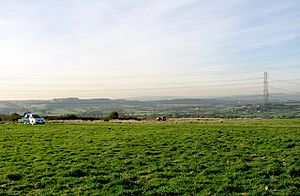Battle of Stalling Down facts for kids
Quick facts for kids Battle of Stalling Down |
|||||||
|---|---|---|---|---|---|---|---|
| Part of Welsh Revolt | |||||||
 Stalling Down |
|||||||
|
|||||||
| Belligerents | |||||||
| Commanders and leaders | |||||||
Rhys Gethin Cadwgan Y Fwyell |
|||||||
| Strength | |||||||
| Unknown | Unknown | ||||||
| Casualties and losses | |||||||
| Heavy | |||||||
The Battle of Stalling Down, also called the Battle of Bryn Owain, was a big fight that probably happened around 1403 or 1405. It was part of the Welsh Revolt, a time when the Welsh people fought for their freedom from England. In this battle, a Welsh army led by Owain Glyndŵr faced off against an English army led by King Henry IV of England.
Contents
Where Did the Battle Happen?
Stalling Down is an open, hilly area near the town of Cowbridge. Today, it's known as the common land of St Hilary in the Vale of Glamorgan. The exact spot where the battle took place isn't fully known. However, locals call the general area Bryn Owain, which means "Owain's Hill."
A very old Roman road crosses this hill. This road would have been a good path for a large English army to travel along.
Who Fought in the Battle?
The Welsh army had soldiers from Morgannwg. These forces were led by Rhys Gethin, whose name means 'swarthy Rhys'. Another group came from the Rhondda Valleys region. This group was led by Cadwgan, Lord of Glyn Rhondda.
Cadwgan lived near what is now Treorchy. He was known for fighting with a battleaxe. Later, people called him Cadwgan of the Bloody Axe. It is also believed that Owain Glyndŵr himself was present and fought in this battle.
What Was the Result?
Reports say the battle lasted for a very long time, about 18 hours. It was a terrible defeat for the King's English army. Some stories say the blood was so deep it reached the horses' fetlocks (the part of a horse's leg just above the hoof).
The English army had to retreat through Cardiff. The Welsh chased them in very bad weather. There was a thunderstorm and heavy flooding, making their escape even harder.
What Do We Know About the Battle?
In 1896, workers were improving a church in nearby Llanblethian. They found an old oak plank in the floor. When they lifted it, they discovered a stone stairway leading down to a secret room called a crypt.
Inside this crypt, there were about 300 male skeletons. They were piled up without coffins. The only known battle in this area was Stalling Down. The crypt was about 17 feet long and 15 feet wide. It was 7 feet high at its tallest point. Small openings to the outside had been covered with earth, sealing the crypt. The bones were quickly reburied in the churchyard.
A special inscription in the church mentions the Sweeting family. It says they were buried there "before the war with Owen Glyndŵr." The church is about three miles from where the battle is thought to have happened.
Some historians today are not sure if the battle really happened. For example, a modern expert on Glyndŵr, R. R. Davies, didn't mention it in his book. This is because the first mention of the battle came much later, from an 18th-century historian named Iolo Morganwg. However, many writers after him, like Arthur Bradley in 1901, repeated Morganwg's story. Bradley even called it the 'battle of Bryn Owen' and placed it in 1405.
Even with this uncertainty, we can't say for sure that the Battle of Stalling Down never happened. The discovery of 300 skeletons in a crypt nearby is a strong clue. Also, there are many local stories about the battle. The idea of a battle happening in 1403 or 1405 fits with what we know about Glyndŵr's revolt. We know Glyndŵr was near Carmarthen in 1403. It's possible that an English army moved into Glamorgan along the Roman road, leading to a fight like the Battle of Stalling Down.

